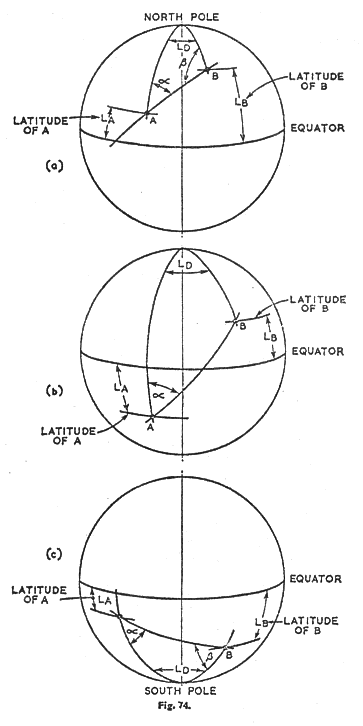
This is the method for calculating great-circle distances that Mike Saunders refers to in his Pyramid Folio comments. It is wrong; for correct formulae, see the comment at the end.
The distance between two places on the earth’s surface may be calculated provided the latitudes and longitudes of the places are known.

Let A and B be two places on the earth’s surface, as shown in Fig. 71The diagram labelled Fig. 74 seems to be meant., the angles α and β at A and B of the great circle passing through the two places and the distance D between A and B along the great circle can be calculated as follows:
Let B be the place of greater latitude (nearer the pole).
LA is the latitude of A
LB is the latitude of B
LD is the longitude difference between A and B.
| Then, tan | β − α | = cot | LD | sin½(LB − LA) | |
| 2 | 2 | cos½(LB + LA) | |||
| and tan | β + α | = cot | LD | cos½(LB − LA) | |
| 2 | 2 | sin½(LB + LA) |
| give the values of | β − α | and | β + α |
| 2 | 2 |
| from which | β + α | + | β − α | = β |
| 2 | 2 | |||
| and | β + α | − | β − α | = α. |
| 2 | 2 |
In the above it is convenient to take northern latitudes as positive and southern as negative. If both places are in the southern hemisphere, LB − LA will be negative and it is simpler to refer the calculation to the South pole making suitable conversion with respect to North later if necessary. The distance D (in degrees) along the great circle between A and B is given by:
| tan | D | = tan | LB − LA | · | sin½(β + α) | Wrong |
| 2 | 2 | cos½(β − α) |
Then to convert the angular distance D (in degrees) to linear distance:
D in degrees × 69.057 = miles
D in degrees × 111.136 = kilometres
Note it is more convenient to use decimals for the minutes and seconds of degrees.
Comment by Michael Behrend, May 2014
Whilst the above method gives the bearings α and β correctly, the formula for the distance D is clearly wrong, since it makes D = 0 whenever A and B are on the same latitude. A correct formula along the same lines is
| tan | D | = tan | LD | · | cos½(LB + LA) | · | sin½(β + α) | . |
| 2 | 2 | cos½(LB − LA) | cos½(β − α) |
However, as pointed out in the comments by Bob Schadewald, the angular distance D can be found more simply from
| cosD = cosLA cosLB cosLD + sinLA sinLB , |
after which D can be converted from degrees to miles or kilometres as above. If the points A and B are close together, it may be more accurate (because of rounding errors) to use the alternative formula
| sin2 | D | = cosLA cosLB sin2 | LD | + sin2 | LB − LA | . |
| 2 | 2 | 2 |